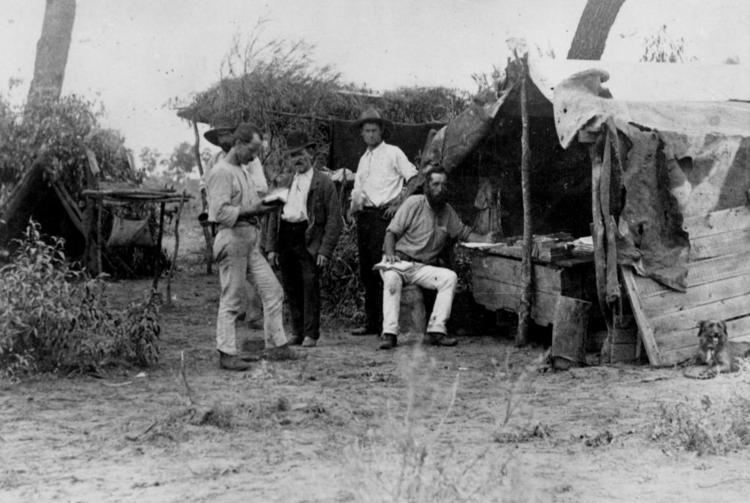 | ||
The 1891 shearers' strike is one of Australia's earliest and most important industrial disputes.
Contents
The dispute was primarily between unionised and non-unionised wool workers. It resulted in the formation of large camps of striking workers, and minor instances of sabotage and violence on both sides. The strike was poorly timed, and when the union workers ran out of food, they were forced to come to terms. The outcome is credited as being one of the factors for the formation of the Australian Labor Party and the rise to power of a pro-Labor Party faction in the Australian Socialist League.
Background
Working conditions for sheep shearers in 19th century Australia were not good. In 1891 wool was one of Australia's largest industries. But as the wool industry grew, so did the number and influence of shearers.
By 1890, the Australian Shearers’ Union boasted tens of thousands of members, and had unionised thousands of sheds. At their annual conference in Bourke in 1890, the Union laid down a new rule, which prohibited members from working with non-union workers. Soon after, shearers at Jondaryan Station on the Darling Downs went on strike over this issue. As non-union labour was still able to process the wool, the Jondaryan shearers called for help. The Rockhampton wharfies responded and refused to touch the Jondaryan wool. The unionists won the battle. This galvanised the squatters, and they formed the Pastoralists’ Federal Council, to counter the strength of the unions. The Australian Socialist League also involved itself directly with the shearers as the strike loomed (which would lead to its involvement in the foundation of the Australian Labor Party).
The strike
Many union shearers were outraged when Logan Downs Station Manager Charles Fairbain asked the shearers to sign a contract that would reduce the power of their union. On 5 January 1891 the shearers announced a strike until the following demands for a contract were met:
The strike started and quickly spread. From February until May, central Queensland was on the brink of civil war. Striking shearers formed armed camps outside of towns. Thousands of armed soldiers protected non-union labour and arrested strike leaders. The unionists retaliated by raiding shearing sheds, harassing non-union labour and committing acts of sabotage, although the incidents of actual violence or arson were few.
One of the first May Day marches in the world took place during the strike on 1 May 1891 in Barcaldine. The Sydney Morning Herald reported that 1340 men took part of whom 618 were mounted on horse. Banners carried included those of the Australian Labor Federation, the Shearers' and Carriers' Unions, and one inscribed 'Young Australia'. The leaders wore blue sashes and the Eureka Flag was carried. The "Labor Bulletin" reported that cheers were given for "the Union", "the Eight-hour day", "the Strike Committee" and "the boys in gaol". It reported the march:
"In the procession every civilised country was represented doing duty for the Russian, Swede, French, Dane etc, who are germane to him in other climes, showing that Labor's cause is one the world over, foreshadowing the time when the swords shall be turned into ploughshares and Liberty, Peace and Friendship will knit together the nations of the earth."But the shearers were unable to hold out. The summer had been unseasonably wet, and the strike was poorly timed for maximum effect on the shearing season (winter). By May the union camps were full of hungry penniless shearers. The strike had been broken. The squatters had won this time, but it had proved a costly exercise.
Thirteen union leaders were charged with sedition and conspiracy, taken to Rockhampton for the trial, convicted, and sentenced to three years in gaol on St Helena Island Prison. The 1891 shearers' strike is credited as being one of the factors for the formation of the Australian Labor Party. Three of those imprisoned (William Hamilton, Julian Stuart, and George Taylor) later became Labor members of parliament – Hamilton in Queensland and the other two in Western Australia.
Legacy
The site of the striking shearers' campsite in Barcaldine is listed on the Queensland Heritage Register.
